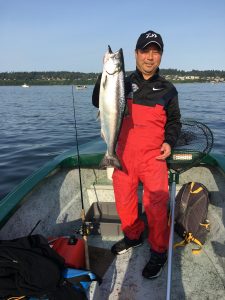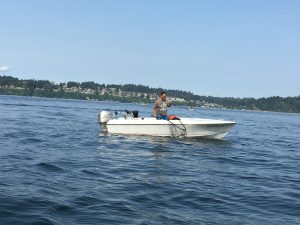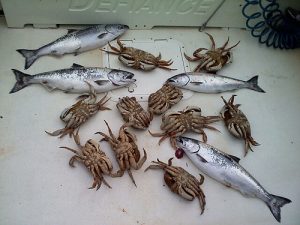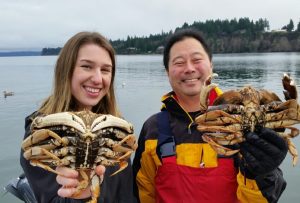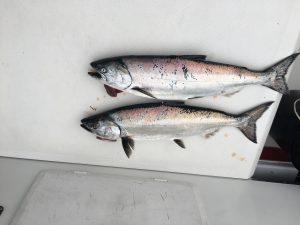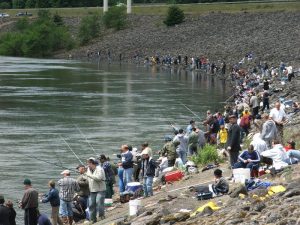Early chinook action in Tacoma like the “good old days” and Puget Sound crab seasons announced Leave a reply
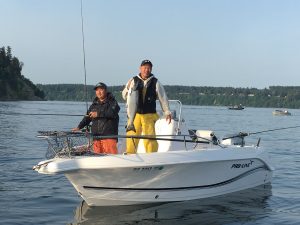
Benny Wong of Seattle holds up a hatchery king he caught off the Clay Banks at Point Defiance. Fishing has been very good since it opened on June 1.
If the first 10 days of June are any indication of what’s to come this summer for Puget Sound chinook then hold on tightly to your fishing pole as there will be plenty of action on the horizon.
The spotlight is shining brightly on south-central Puget Sound in the Tacoma area (Marine Catch Area 11) although southern Puget Sound (Area 13) has also garnered its glory moments around Fox Island where a 30-pound native king was released last week.
“We’ve had more than 100 fish checked into the boathouse since we opened on June 1, and it has remained pretty consistent,” said Art Tachell, the manager of the Point Defiance Park Boathouse in Tacoma. “This early part of the summer reminds me of what we used to see in the good old days.”
I fished the Clay Banks and “Flats” off Point Defiance Park late last Wednesday, and it wasn’t uncommon to see four or five anglers hooked up on each drift. This scenario carried on at daybreak clear into the mid-morning tide change. Jigging and meat-lining are the “go to” techniques, but some are mooching herring (until the dogfish show up, which could be anytime now) and downrigger trolling.
Look for a mix of mature kings, 10 to 16 pounds, and resident feeder chinook, 5 to 8 pounds, from Owens Beach to the Clay Banks and Point Dalco off south side of Vashon Island.
Other options to start looking at even though the peak timing is later in summer are Dolphin Point, Brace Point, Point Robinson, Three Tree Point and the south side of the Southworth Ferry Landing.
The daily limit is two salmon, but only one can be a hatchery-marked chinook – release wild chinook – with a 5,300 chinook catch quota.
“We haven’t had a lights-out season in Area 11 since we started a marked selective fishery for chinook in 2007 (when about 12,000 chinook were caught),” said Mark Baltzell, a WDFW salmon manager.
The biggest catch of legal-marked chinook was 2008 when 7,200 were kept and since then largest catch occurred in 2012 when 4,800 were kept.
Area 11 is known to start off good usually during the first week of the opener and then gradually turns into an on-and-off again fishery as waves of fish migrate into the area.
“My biggest concern this summer is that we’ve got a higher abundance of hatchery chinook coming back to the Deschutes, Nisqually and Puyallup,” Baltzell said. “I am hopeful we can make it through August, but we’ll see where it goes and how long it lasts.”
This year’s projection of 227,420 hatchery chinook migrating through Puget Sound is up 21 percent from the 10-year average and is a 35 percent increase over last year.
Big baitfish (herring, anchovy and candlefish) schools are swarming in the Tacoma area and will likely have the salmon making a pit-stop before moving on to spawning grounds.
Word on Dungeness crab
The highly popular Dungeness crab season gets underway in many Puget Sound areas on June 30 although the Strait of Juan de Fuca from Neah Bay to Sekiu opens June 16.
“It is fair to say that north of Area 10 (central Puget Sound) should see a decent Dungeness crab season this summer,” said Don Velasquez, a WDFW Puget Sound shellfish manager.
Fishing in open areas will be allowed Thursdays to Mondays of each week (closed Tuesdays and Wednesdays). The crab fishery is closed on July 4. South-central and southern Puget Sound (Marine Catch Areas 11 and 13) are closed this summer due to a poor Dungeness crab abundance.
The eastern Strait of Juan de Fuca around Port Angeles (6); Deception Pass (8-1); Port Susan/Everett (8-2); northern Puget Sound/Admiralty Inlet (9); central Puget Sound (10); and Hood Canal (12) are open June 30 through Sept. 3.
The western Strait of Juan de Fuca from Neah Bay east of the Bonilla-Tatoosh Island boundary to Sekiu (4 and 5) are open June 16 through Sept. 3.
The San Juan Islands/Bellingham (7 South) are open July 14 through Sept. 30, and the San Juan Islands “Gulf of Georgia” (7 North) are open Aug. 16 through Sept. 30.
In all inland marine catch areas, the total Dungeness crab harvested in 2017 season was 9,285,912 pounds in all fisheries compared to 10,645,000 in 2016.
In San Juan Island region north to Canadian border there was 5,096,978 pounds landed; northern Puget Sound and east side of Whidbey Island, 2,988,573 pounds; in Strait of Juan de Fuca east of Neah Bay to Admiralty Inlet, 864,103 pounds; central Puget Sound, 116,709 pounds; Hood Canal, 184,001 pounds; south-central Puget Sound, 26,086 pounds; and southern Puget Sound, 9,462 pounds.
The state harvest Puget Sound-wide (includes Hood Canal and Strait of Juan de Fuca) in 2016 for Dungeness crab was 5,295,000 pounds for sport and non-tribal fishermen, and of that the sport catch total was 2,381,000 pounds. Tribal fishermen caught 5,350,000 pounds.
This comes on the heel of an all-time record catch in 2015 when state and tribal Puget Sound Dungeness crab fisheries landed 11.8 million pounds, exceeding the previous 2014 record by 1.2 million pounds.
In 2016, the sport Puget Sound crab endorsement was 223,443 down from 232,621 in 2015.
The summer — mid-June through September — sport fishery continues to have the highest participation level with 88.7 percent of the yearly sport catch, according to state Fish and Wildlife catch data.
General Puget Sound rules are crab pots may not set or pulled from a vessel from one hour after official sunset to one hour before official sunrise. All shellfish gear must be removed from the water on closed days.
Crabbers must immediately write down their catch record cards after retaining Dungeness crab. Separate catch record cards are issued for the summer and winter seasons.
Catch record cards are not required to fish for Dungeness crab in the Columbia River or on the Washington coast.
The daily limit in Puget Sound is five male Dungeness crab in hard-shell condition with a minimum carapace width of 6¼ inches. Fishermen may also keep six red rock crab of either sex daily, and each must measure at least 5 inches.
Those looking to get a jump start on Dungeness crab can head to the coast from Ilwaco north to Neah Bay west of the Bonilla-Tatoosh Island boundary, which is currently open daily.
For more information go to http://wdfw.wa.gov/fishing/shellfish/crab/.
Nibbles and bites
The light switch turned on for resident coho in central Puget Sound with the local charter fleet hooking into limits of 2 to 4 pounders along with some kings released.
“Some of the charter guys were getting five or six a day along with a few limits, and its definitely picked up from the slow start (on June 1),” said Gary Krein, owner of All-Star Charters in Shilshole Bay/Everett.
While the spot has been focused on the shipping lanes off Jefferson Head it appears coho have been found at Kingston and Richmond Beach. It’s an easy fishery where you get the gear just below the surface of the water but no deeper than 30 feet. Downsizing of gear is essential with a shorter Hot Spot chrome dodger and a small plastic squid or Coho Killer. Also try a diver with a firecracker size cut-plug herring for those “downrigger-less” in Puget Sound.
The Tulalip Bubble Fishery has been giving up a fair number of decent-sized hatchery kings since it opened May 24. It’s open through Sept. 3 with fishing allowed each week from 12:01 a.m. Friday through 11:59 p.m. Monday.
Another location in the marine area that often gets off to a decent early start is the Edmonds Pier where anglers tossing a variety of jigs or a Styrofoam float with a herring drifting underneath often get the fish to bite.
On the freshwater scene, the hatchery king fishery on the open stretch of the Skykomish, Cascade and Skagit rivers got off to a good start as well as the steelhead action on Skykomish at Reiter Ponds.
Many are getting geared up for the sockeye fishery on the Lower Skagit River. The forecast is 35,002 and is comparable to last year’s actual return of 33,359 and still above the historical average.
“This summer’s sockeye return is relative to historic runs and it is still a big number,” said Brett Barkdull, a WDFW biologist. “We’re predicting survival rates are going to be down a fair amount based on ocean conditions.”
“The first year we had a big return was in 2010 and so this summer’s run falls kind of right in the middle,” Barkdull said. “Since then we’ve had returns between 17,800 and a high of 51,000.”
Fad for shad happening now on Columbia
Well it didn’t take long for the Columbia River shad counts to surpass the three-quarter-million mark as single-day counts at Bonneville Dam are huge.
Those single-day count was 157,536 on Tuesday (June 5) and skyrocketed to 197,540 on Wednesday (June 6). The in-season tally to date is 767,566.
WDFW suspect no change in the recent forecasts where they’ve seen anywhere from 1 million to 5 million annually. 3.2 million is the preseason estimate this year.
The 10-year average peak timing for shad usually occurs from early- to mid-June, and typically when daily counts hit 20,000 anglers should make plans on going which obviously is right now.
Some anglers were having 100-plus fish trips, but most were catching between 15 to 20 per rod.
Some of the best fishing occurs along the shoreline just below Bonneville Dam, but shad are spread out in the Camas Slough, and from Washougal downstream to Kalama.
To access the best area below the dam, head east on Highway 14 about two miles past the town of North Bonneville, and take the right-hand turn by the transmission towers. The access road allows anglers about three miles of prime shoreline in either direction.
Shad tend to like a fast running current, and most fish usually are caught no further than 30 feet from shore.
Shad darts are the most effective lure, but red- and white-colored flies with a small hook, colored beads like red or a metallic silver or gold, small crappie-like jigs and small wobbler-type spoons or spinners will do the job.


